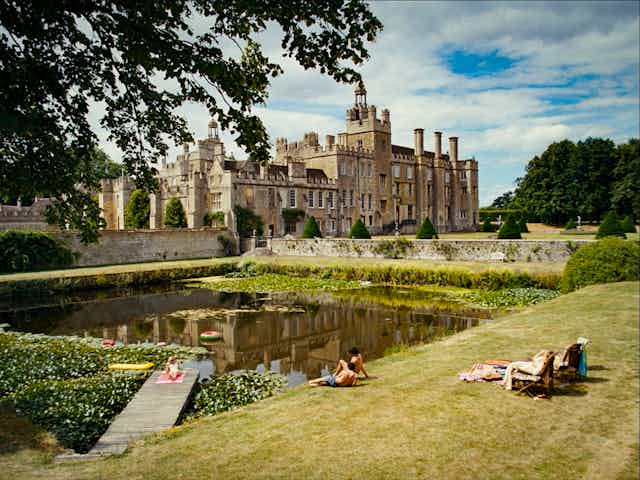Ever since I first read Evelyn Waugh’s Brideshead Revisited as a master’s students many years ago, I have been smitten. Literary trends and fashions come and go, but I still return to Brideshead every couple of years for sheer reading pleasure.
Undoubtedly Waugh’s most famous novel, Brideshead Revisited was first published in 1945 after the second world war. Its narrative is deeply imbued with nostalgia for an unspoilt, quasi-mythical rural England of stately homes and bright young upper-class people that, it can be argued, never really existed in the first place.
Waugh’s protagonist is Charles Ryder, a young middle-class man with social aspirations, whio meets and befriends the upper-class Sebastian Flyte while at Oxford. Ryder is seduced by the easy charm and carefree attitude of Sebastian, an infatuation that only increases once Ryder accompanies Sebastian to his ancestral home, Brideshead, and meets his family.
This storyline is emulated in English director Emerald Fennel’s new film, Saltburn. The film follows Oliver Quick (Barry Keoghan), an awkward student who is trying to find his place at Oxford. Quick is taken under the wing of the charming and aristocratic Felix Catton (Jacob Elordi), who invites him to spend a memorable summer at his sprawling family estate Saltburn.
A riveting thriller, the film is also deeply nostalgic for an England of stately homes full of hedonistic, bright young things. It shows the timelessness of Waugh’s story and your appreciation for Saltburn will only be strengthened by getting to know the novel that inspired it.
A lost upper-class world
For Ryder, life at Brideshead offers glimpses into a world he aspires to – a world of connections, money, and an assured self-confidence that comes from generations of privilege. Seduced by the lifestyle, Ryder fails to see that Flyte battles his own demons and the pressures of his Catholic family. Eventually, Flyte succumbs to alcoholism and the friends lose touch with each other.
Years later, during a cruise, Ryder, now a relatively successful painter and unhappily married, meets Flyte’s sister Julia and the two start an affair. Both plan to divorce their respective partners and start a life together at Brideshead. But, once again, Ryder fails to read the signs.
Julia, also raised a Catholic, caves in to pressure and renounces the relationship, which her faith judges immoral and wrong. The novel ends as it has started – at a war-time Brideshead which, requisitioned by the army, has fallen into disrepair. Ryder now has also converted to Catholicism and is reminiscing about the past while seeking solace in the chapel.
This brief plot summary does not do justice to a novel that stands out because of its beautiful and haunting prose and its depictions of pre-war British society. Waugh was a gifted writer and the evocation of a lost upper-class world was something particularly close to his own heart.
Brought up in a literary middle-class family – his father was the writer, publisher and literary critic Arthur Waugh, his older brother was the novelist Alexander “Alec” Waugh – he had considerable social aspirations. Barred from Eton due to the scandalous publication of his brother’s novel The Loom of Youth (1917), he was educated at Lancing College and Oxford University.
Waugh always maintained that not having been at Eton precluded him from being fully accepted by his many upper-class friends. After a brief – and pretty disastrous – career as a public-school teacher, Waugh turned to writing full-time, both as a journalist and as a novelist.
His early novels stand for through their social satire and modernist style, satirising the fast and furious lifestyle of what he came to term the “Bright Young Things” of upper-class society, flitting from entertainment to entertainment.
Read more: How 1920s high society fashion pushed gender boundaries through 'freaking' parties
Modern invocations
Waugh converted to Catholicism in 1930 and his writing style changed considerably from that point onwards. His novels became more nostalgic and wistful in tone.
Brideshead is the culmination of that later career stage, bringing together several preoccupations close to Waugh’s own heart. Although it is no longer fashionable to combine an author’s biography with literary criticism, it is certainly possible to say that there is a lot of Waugh himself, albeit probably subconsciously, in the depiction of Charles Ryder who tries so hard – via Sebastian, via Julia, via Catholicism – to become a part of Brideshead and its family.

While Waugh subtitled Brideshead Revisited: The Sacred and Profane Memories of Captain Charles Ryder, giving it the framework of a biographical coming-of-age story, it is, from a 21st-century perspective, particularly rewarding to read the novel in a way that might have been unintended by Waugh. That is as the story of a relentless social climber who will change, chameleon-like, love, interests and affiliations in the pursuit of social status. This 21st century take is also what is being teased out in Fennel’s re-imagined Brideshead, Saltburn.
The stylistic beauty of Brideshead Revisited, its character dynamics and thematic focal points, have been the inspiration for many other novels – Alan Hollinghurst’s The Line of Beauty (2004) or Sarah Waters’ The Little Stranger (2009), for instance. Despite being published in 1945 and seemingly dealing with societal issues no longer considered of relevance in contemporary society, Brideshead has a perennial influence in British literature and culture – a modern classic that is always worth reading and rereading.

Looking for something good? Cut through the noise with a carefully curated selection of the latest releases, live events and exhibitions, straight to your inbox every fortnight, on Fridays. Sign up here.

